Understanding Cellulose Ether Prices Factors and Market Trends
Cellulose ethers are a class of water-soluble polymers derived from cellulose, the most abundant organic polymer on Earth. These compounds are widely used in various industries, including pharmaceuticals, food, cosmetics, and construction, primarily due to their thickening, binding, and film-forming properties. As global demand for cellulose ethers continues to rise, understanding the factors influencing cellulose ether prices becomes essential for businesses and consumers alike.
Factors Affecting Cellulose Ether Prices
1. Raw Material Costs The price of cellulose ethers is closely tied to the cost of raw materials, primarily cellulose derived from wood pulp, cotton, or other plant sources. Fluctuations in the availability and prices of these raw materials due to factors like climatic conditions, deforestation, and market demand have a direct impact on cellulose ether pricing. For instance, a shortage of wood pulp caused by increased environmental regulations or natural disasters could significantly increase costs for manufacturers.
2. Production Processes The production of cellulose ethers involves complex chemical processes, including etherification, which can be resource-intensive. Energy prices, labor costs, and advancements in production technology can all influence overall manufacturing costs. If energy prices rise due to geopolitical tensions or regulatory changes, manufacturers may pass these costs onto consumers in the form of higher prices.
3. Global Demand The demand for cellulose ethers is growing due to their versatile applications. In the pharmaceutical industry, they are used as excipients, while in the food industry, they serve as thickeners and stabilizers. As populations grow and industries expand, the global appetite for cellulose ethers is likely to increase, exerting upward pressure on prices.
4. Alternative Materials The emergence of alternative synthetic and natural products can also influence cellulose ether prices. If viable and cheaper substitutes become available, manufacturers may face competitive pressure to adjust their pricing strategies. Conversely, a lack of alternatives may enable cellulose ether producers to maintain or increase prices.
5. Regulatory Environment Regulations regarding product safety and environmental impacts can affect production processes and costs. Compliance with stringent regulations can increase manufacturing expenses, thus impacting the market price of cellulose ethers. Additionally, changes in trade policies and tariffs can lead to price volatility, especially in global markets.
cellulose ether price

6. Market Competition Competition among manufacturers plays a crucial role in determining cellulose ether prices. A highly competitive market can drive prices down, while a monopolistic or oligopolistic market may lead to higher prices. Mergers and acquisitions in the industry can affect competition levels and pricing dynamics.
Current Market Trends
As of late 2023, the cellulose ether market is experiencing notable shifts. There is an increasing trend towards sustainable and bio-based products, which is pushing some manufacturers to invest in eco-friendly cellulose ether production methods. This change, while beneficial from an environmental standpoint, may lead to increased production costs initially, potentially influencing prices in the short term.
The COVID-19 pandemic has also had lasting effects on supply chains, impacting the availability of raw materials and transportation costs. Recovery from pandemic-related disruptions continues to affect market dynamics, which can lead to price fluctuations.
Moreover, the shift in consumer preferences toward clean-label products in the food and cosmetics industries is driving demand for natural cellulose ethers that are considered safe and environmentally friendly. This trend may enhance the competitive landscape, leading to innovation in product offerings and potentially affecting pricing strategies.
Conclusion
In summary, cellulose ether prices are influenced by a complex interplay of factors, including raw material costs, production processes, global demand, alternatives in the market, regulatory landscapes, and competition among manufacturers. As industries evolve and consumer preferences shift, staying informed about these factors is crucial for stakeholders in the cellulose ether market. Whether you are a manufacturer, supplier, or end-user, understanding market trends and dynamics can help navigate the challenges of pricing and sourcing in this essential industry.
-
The Application and Significance of Construction RdpNewsMay.19,2025
-
Industrial Grade HpmcNewsMay.19,2025
-
Building Coating Adhesive Building Coating Adhesive HpmcNewsMay.19,2025
-
Application Of Hpmc For Detergent For Detergent In DetergentsNewsMay.19,2025
-
Application Of Hpmc Cellulose In Cement-Based MaterialsNewsMay.19,2025
-
Application Of High Quality Hpmc For Construction In The Field Of ConstructionNewsMay.19,2025




